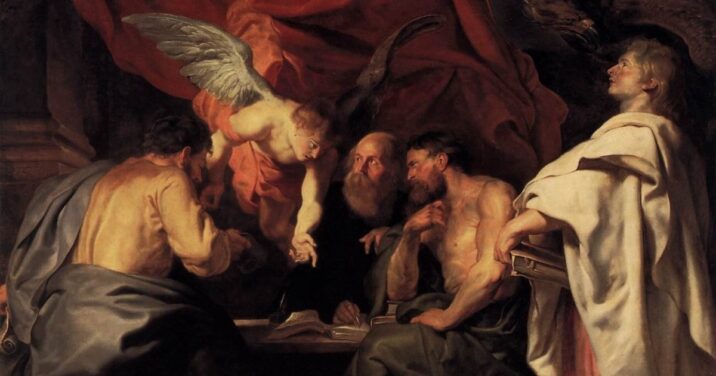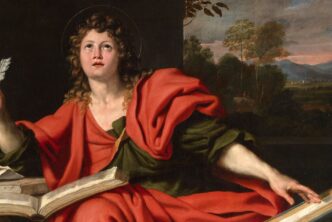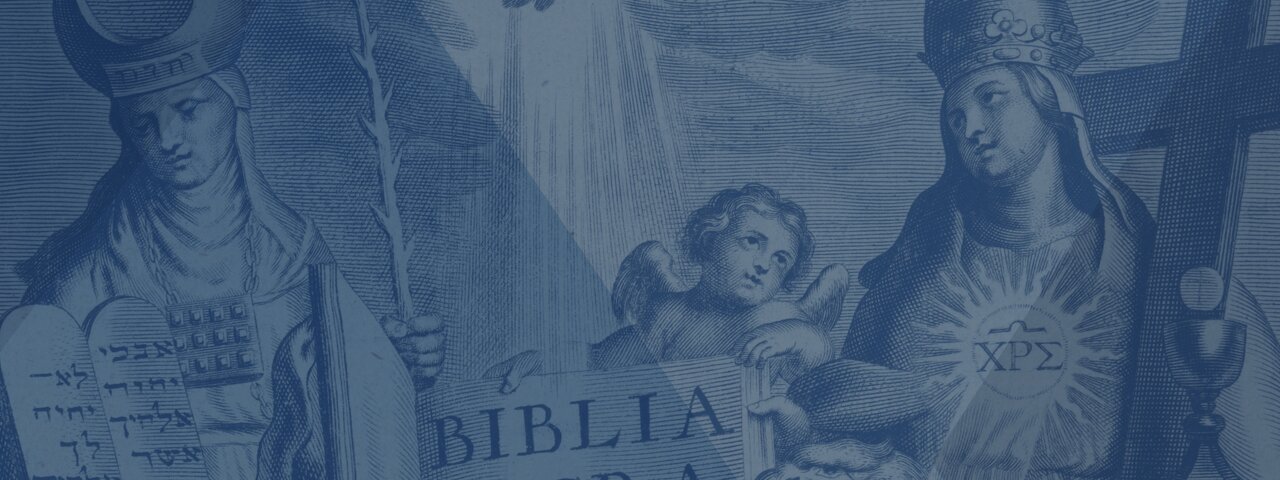In the document Dei Verbum (DV), which translates from Latin to “The Word of God,” the Second Vatican Council set forth with greater clarity than ever before the foundation of Catholic faith and practice in Scripture and Tradition. The Council’s aim was to update the Church’s teaching on these topics, especially in light of new developments in biblical scholarship. This article will briefly summarize Dei Verbum’s main teachings and will conclude by reflecting on its implications for the life of the Church today.
The process by which the Second Vatican Council produced this document was an arduous one. The Council Fathers rejected the original schema for the document drafted before the Council by members of the relevant Vatican departments. Pope John XXIII then appointed a new committee that included cardinals and theologians of diverse perspectives to draft a revised document.
In all, Dei Verbum went through six different drafts before it won nearly unanimous approval by the Council (the final vote was 2334 in favor, 6 opposed). The final version, promulgated November 18, 1965, manifests a mature and nuanced expression of the Church’s understanding of divine revelation in a mere ten pages (not counting footnotes).
As a dogmatic constitution of an ecumenical council, Dei Verbum bears the highest doctrinal authority a Church document can have.
What is revelation and how are we to respond?
In the document’s brief preface, the Council Fathers quote 1 John 1:2–3, which speaks of announcing what Jesus revealed to his disciples; namely, “the eternal life which dwelt with the Father.” The goal of this proclamation was that readers, and potentially the whole world, could have fellowship (koinonia) with Jesus’s disciples and with the Father, Son, and Holy Spirit. By explaining and proclaiming what God has revealed, Vatican II follows in the footsteps of the Council of Trent (1545–63) and the First Vatican Council (1869–70), which also taught about divine revelation in Scripture and Tradition in response to the challenges and questions of their day.
In explaining what revelation is, Dei Verbum begins by declaring that “God chose to reveal Himself,” emphasizing the personal character of divine revelation. It then repeats that God’s purpose was to bring us into relationship with himself. Nevertheless, the objective doctrinal content of revelation is also indicated by the statement that God has revealed “the hidden purpose of his will” and that God’s revelation consists of both the deeds God accomplished in salvation history as well as the inspired words that proclaim and explain those deeds. Through these words and deeds that have an inner unity, God reveals the deepest truth about himself and about human salvation. Above all, God has revealed Christ, “who is both the mediator and the fullness of all revelation” (DV 2).1
The chapter concludes with the appropriate response to divine revelation, “the obedience of faith … an obedience by which man commits his whole self freely … to God who reveals” (see Rom 13:26). This response is made possible by grace and the interior help of the Holy Spirit.
How do we know what God has revealed?
Chapter 2, the second longest chapter, is titled “Handing on Divine Revelation,” and it clarifies and nuances Catholic teaching regarding the roles of Scripture, Tradition, and the Magisterium, particularly as regards controversies that arose at the time of the Protestant Reformation.
It explains that God graciously saw to it that his plan of salvation would be announced to all nations and preserved in its integrity “to all generations.” He did this through Christ who commissioned his apostles to proclaim to all nations the gospel of salvation “by their oral preaching, by example, and by observances … they had received from Christ” as well as what they received from the Holy Spirit (John 16:13). Under the inspiration of the Holy Spirit, the apostles both wrote down this message of salvation in the books of the New Testament and left bishops as their successors to teach in their place.
God’s intention was that the apostolic preaching that is preserved in the inspired books would also be preserved in “an unending succession of preachers until the end of time” (DV 8). The word “tradition” derives from a verb that means to hand on or deliver (Latin, tradere; Greek, paradidōmi) and refers to what has been “handed on” (see 1 Cor 11:2, 23; 15:3). Dei Verbum defines what was handed on by the apostles—Sacred Tradition—as “everything which contributes toward the holiness of life and increase in faith of the peoples of God,” that is, what “the Church in her teaching, life and worship, perpetuates and hands on to all generations, all that she herself is, all that she believes” (DV 8). So the Catholic understanding of Tradition is not merely unwritten doctrines, but the transmission through time of the Church’s own life.
Dei Verbum acknowledges that with the help of the Holy Spirit there is a development in this Tradition, a deepening in the Church’s understanding of the truth she has received. This living Tradition is manifest in the teaching of the Fathers of the Church, who themselves reflect on the meaning of the Scriptures. The Church’s discernment of the canon of Scripture, the decision regarding which books belong in the Bible, is itself a fruit of Tradition.
Articles 9 and 10 address the relationship between Scripture, Tradition, and the Church’s teaching office (Latin, magisterium). Reacting to abuses in Catholic preaching and practice, the Protestant Reformation rejected Tradition as authoritative for Christian life, only accepting the authority of Scripture (sola Scriptura). In contrast to some catechesis before the Council, Dei Verbum affirms that Sacred Scripture and Sacred Tradition should not be understood as separate sources of divine revelation. Rather, “both of them, flowing from the same divine wellspring … tend toward the same end. Scripture is the word of God … consigned to writing under the inspiration of the divine Spirit, while Sacred Tradition takes the word of God entrusted by Christ the Lord and the Holy Spirit to the Apostles, and hands it on to their successors” (DV 9). Both modes of divine revelation, Scripture and Tradition, are to be held with equal respect and reverence. Together they “form one sacred deposit of the word of God” entrusted to the Church.
The Church’s teaching office is not itself a source of divine revelation, but rather has the role of being revelation’s authoritative interpreter. The subordination of the Magisterium to Scripture and Tradition is clearly expressed:
This teaching office is not above the word of God, but serves it, teaching only what has been handed on, listening to it devoutly, guarding it scrupulously and explaining it faithfully in accord with a divine commission and with the help of the Holy Spirit, it draws from this one deposit of faith everything which it presents for belief as divinely revealed. (DV 10)
The chapter concludes by emphasizing that Sacred Tradition, Sacred Scripture, and the teaching office of the Church are so “joined together that one cannot stand without the others” (DV 10), not unlike a three-legged stool.
The inspiration and truth of Sacred Scripture
The remaining four chapters of Dei Verbum focus on Sacred Scripture.
Chapter 3 addresses both the divine inspiration of Scripture and its proper interpretation, which will be considered here under separate headings.
The Catholic Church’s extraordinarily high regard for Sacred Scripture is evident in this chapter which affirms that all of the books of the Old and New Testaments “in their entirety, with all their parts” were written under the inspiration of the Holy Spirit, and therefore “have God as their author.” Rather than dictating the Bible word for word (as some earlier theories of inspiration speculated), God chose and worked through human authors who “made use of their powers and abilities … as true authors, consigned to writing everything and only those things which he wanted” (DV 11). Thus it is legitimate to speak of the “dual authorship” of Sacred Scripture.
This nuanced understanding was an important development, since in defense against Enlightenment attacks on the Bible an earlier draft of the document had asserted “the absolute immunity from error of Scripture … in every matter both sacred and profane” (DV 11). But during the Council, Cardinal Koenig of Vienna gave a speech in which he pointed out several biblical inaccuracies regarding scientific and historical matters. The consequence was a shift from speaking about the inerrancy of Scripture to speaking about the truth it proclaims. Here is the Council’s final affirmation:
Since, … all that the inspired authors … affirm should be regarded as affirmed by the Holy Spirit, we must acknowledge that the books of Scripture, firmly, faithfully and without error, teach that truth which God, for the sake of our salvation, wished to see confided to the Sacred Scriptures. (DV 11)
Some have misconstrued this statement as limiting the truth of Scripture to passages related to salvation. However, the Council specifically rejected that proposal and included the phrase “for the sake of our salvation” to highlight the vital divine purpose for which the books of the Bible “in their entirety, with all their parts” proclaim the truth. God did not intend to give us the Bible as an infallible historical or scientific text, but rather as a trustworthy guide to salvation.
How should Catholics interpret the Bible?
The dual authorship—human and divine—of Sacred Scripture calls for a twofold consideration for its proper interpretation. On the one hand, the interpreter “should carefully investigate what meaning the sacred writers really intended,” and on the other, “what God wanted to manifest by means of their words.” The human author’s intention expressed in the text (the literal sense) is ascertained by a careful study of the meaning of the words in their historical and literary contexts. The interpreter should be aware of the diverse genre and literary forms present in biblical texts and “the customary and characteristic styles of feeling, speaking and narrating which prevailed at the time of the sacred writer” (DV 12).
On the other hand, since Sacred Scripture is divinely inspired, “it must be read and interpreted in the light of the same Spirit by whom it was written” (DV 12). Dei Verbum then sets forth three theological criteria for interpreting Scripture “in the same Spirit.”
1. Interpreters must consider the “content and unity of the whole Scripture” (DV 12)
In other words, individual texts must be interpreted in harmony with the whole Bible, since it derives from one divine Author.
2. Scripture must be read within “the living Tradition of the whole Church” (DV 12)
In other words, interpretations must be compatible with the faith and practice of the Church through the ages. To do this, an interpreter takes into account authoritative doctrinal and liturgical traditions and the writings of the Fathers and Doctors of the Church.
3. Interpreters must be attentive to the “analogy of faith” (DV 12)
The Catechism explains the “analogy of faith” as “the coherence of the truths of faith among themselves and within the whole plan of Revelation” (CCC 114). In other words, biblical interpretations must be consistent with the whole of Christian doctrine.
The Council expresses the hope that, if exegetes follow these rules of interpretation, the Church’s understanding of divine revelation will deepen and mature. The final authority regarding the interpretation of Scripture belongs to the Church “which carries out the divine commission and ministry of guarding and interpreting the word of God” (DV 12).
Chapter 3 concludes by likening the dual nature of Scripture to the two natures of Christ: “the words of God, expressed in human language, have been made like human discourse, just as the word of the eternal Father, when He took to Himself the flesh of human weakness, was in every way made like men” (DV 13).
The importance of the Old Testament
Chapter 4 treats the Old Testament. It begins by recalling God’s plan to save the whole human race by choosing a particular people, Israel, to whom he would reveal himself, his promises, and his plan through words and deeds. For this reason, the books of the Old Testament, which are divinely inspired, “remain permanently valuable” and instructive for Christians (DV 14).
The “principal purpose” of the Old Covenant was to “prepare for the coming of Christ” and “the messianic kingdom” by prophecy and types. The Council acknowledges that the Old Testament “contain[s] some things which are incomplete and temporary” (DV 15). Nevertheless, it reveals God and how he deals with the human race. It contains “sound wisdom about human life, and a wonderful treasury of prayers,” especially the Psalms, and “in them the mystery of our salvation is present in a hidden way” (DV 15).2
The New Testament and the Gospels
Dei Verbum’s chapter on the New Testament begins with a compact yet inspiring summary of the incarnation, ministry, death, resurrection, ascension, and heavenly reign of Christ. It declares that the newness of this revelation was made known to the apostles and Prophets so that they could proclaim the gospel and gather the Church.3
Among the books of the Bible, the four Gospels, which originate with the apostles, hold pride of place because they are “the principal witness for the life and teaching of the incarnate Word, our savior” (DV 18). The Council’s document then proceeds to respond to some scholarly attacks on the historicity of the Gospels with a nuanced statement of the Church’s faith in their historical character. The Church believes firmly that the Gospels “faithfully hand on what Jesus Christ, while living among men, really did and taught for their eternal salvation” (DV 19). Dei Verbum acknowledges that the apostles conveyed these accounts of Christ’s life with the “clearer understanding” (DV 19) available to them after Jesus’s death and resurrection and the gift of the Holy Spirit. It also acknowledges that the authors of the Gospels selected and summarized from the many things that Christ did and said, bearing in mind the situations of the churches and retaining their character of proclamation. Nevertheless, the authors of the Gospels always did so to report “the honest truth about Jesus” (DV 19) as they knew it from their own recollections or from the testimony of other “eyewitnesses and ministers of the Word” (Luke 1:2–4). The chapter on the New Testament concludes by reaffirming the divine inspiration of “the epistles of Paul and other apostolic writings,” which confirm and state Christ’s teaching more fully, report the beginnings and growth of the Church (Acts), and look forward to “its glorious fulfillment” (DV 20).
Sacred Scripture in the life of the Church
It is striking that the longest chapter of Dei Verbum is the chapter devoted to Sacred Scripture in the life of the Church.
The first article (DV 21) stresses the holiness, authority, and personal character of Scripture. “The Church has always venerated the divine Scriptures just as she venerates the body of the Lord.” It is hard to imagine a stronger statement of the Catholic Church’s regard for the holiness of Scripture! Together with Sacred Tradition, the Church regards Scripture “as the supreme rule of faith … Like the Christian religion itself, all the preaching of the Church must be nourished and regulated by Sacred Scripture” (DV 21).
Scripture is more than an authoritative document for doctrine and preaching. It is a marvelous means to personally encounter God himself and to find spiritual nourishment:
In the sacred books, the Father who is in heaven meets His children with great love and speaks with them; and the force and power in the word of God is so great that it stands as the support and energy of the Church, the strength of faith for her sons, the food of the soul, the pure and everlasting source of spiritual life. (DV 21)
Given the vital importance of Scripture for Christian life, it follows that “Easy access to Sacred Scripture should be provided for all the Christian faithful” (DV 22; emphasis added). For centuries in reaction to Protestantism, most Catholic laity regarded Scripture as the domain of the clergy and only knew the portions of Scripture that were read and preached during Mass. But recalling the practice of the ancient Church, Dei Verbum recalls the Church’s use of vernacular translations—especially the Greek Septuagint and Latin Vulgate—in order to make the word of God accessible to all. The Council therefore calls for excellent translations from the original texts of the Bible to be made into various languages—and even to cooperate with “the separated brethren” (i.e., Protestants and Orthodox) in this endeavor so that all Christians will be able to benefit from them (DV 22).
The Council also expresses a desire that the Church’s understanding of the Bible be deepened through the study of Catholic exegetes and theologians who also study the writings of the Church Fathers and the ancient liturgies. The Council Fathers’ hope is for “as many ministers of the divine word as possible” to nourish the people of God, to “enlighten their minds, strengthen their wills, and set men’s hearts on fire with the love of God” (DV 23).
Because Scripture both contains and is the word of God, “the study of the sacred page is, as it were, the soul of sacred theology” (DV 24). And not only theology, but all the Church’s ministry of the word—pastoral preaching (especially homilies), catechesis, and all Christian instruction—is nourished and flourishes “by the same word of Scripture” (DV 24). For this reason, priests, deacons, and catechists should read and study the written word of God, listening to it inwardly before preaching.
At the same time, “all the Christian faithful” should read Scripture frequently so they can grow in their knowledge of Jesus Christ. The Council adds that “prayer should accompany the reading of Sacred Scripture” (DV 25), and then quotes St. Ambrose: “we speak to Him when we pray; we hear Him when we read the divine saying.”4
To aid the laity in reading Scripture, bishops are exhorted to see that suitable editions of the Bible with explanatory footnotes are made available.
Dei Verbum concludes with the hope that “Just as the life of the Church is strengthened through more frequent celebration of the Eucharistic mystery,” that “a new stimulus for the life of the Spirit” will result from an increased reverence for the word of God” (DV 26).
Dei Verbum would be followed up in 2010 by Verbum Domini, the Apostolic Exhortation of Pope Benedict XVI, which goes into more detail about the nature of biblical inspiration and the ecclesial dimension of biblical interpretation.
Read up on Vatican II and how Catholics read Scripture
Ecclesial Exegesis: A Synthesis of Ancient and Modern Approaches to Scripture (Verbum Domini)
Price: $27.99
An Introduction to Vatican II as an Ongoing Theological Event (Sacra Doctrina)
Price: $19.99
Catholic Commentary on Sacred Scripture | CCSS: New Testament Series (17 vols.)
Price: $316.99
Learn more about the Catholic doctrine of Scripture
- Verbum Domini: Everything You Need to Know
- How to Study the Bible Like a Catholic
- What Bible Do Catholics Use? The Most Popular of the Approved
- The next two articles of the first chapter recount the history of salvation, briefly mentioning our first parents, the call of Abraham, the patriarchs, Moses, the prophets and their promise of a Savior, climaxing in the revelation of God in Christ: “To see Jesus is to see his Father” (John 14:9). Contrary to the claims of Muslims and Mormons, Dei Verbum declares, “The Christian dispensation, therefore as the new and definitive covenant, will never pass away and we now await no further new public revelation before the glorious manifestation of our Lord Jesus Christ.”
- God, who inspired both Testaments, “arranged that the New Testament be hidden in the Old and the Old be manifest in the New” (DV 16). The books of the Old Testament “show forth their full meaning in the New … and in turn shed light on it and explain it” (DV 16).
- The writings of the New Testament serve as a “perpetual and divine witness to these realities” (DV 17).
- St. Ambrose of Milan, On the Duties of Ministers I.20.88 (PL 16:50), quoted in DV 25.






